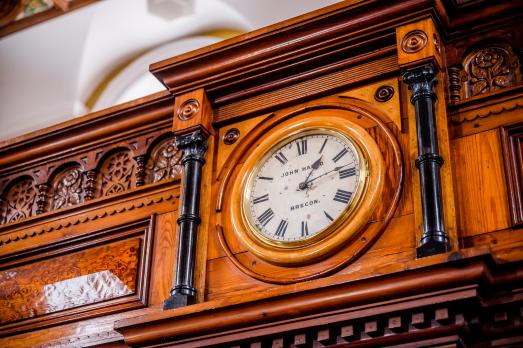Nonconformists were regarded as dissenters and often persecuted. Town dwellers would travel to services in isolated farmhouses. The first chapel here was built for worshippers who had previously met at scattered locations and later at a house in Ship Street, Brecon.
The existing chapel was built in 1841 in classical style, on the former chapel garden. Major rebuilding work was undertaken in 1892 by Benjamin Jenkins, local builder. The chapel has a rectangular plan and a pedimented porch. The entrance is supported by a single cast iron column, with decorative wrought ironwork. A balcony round all four sides of chapel is supported on fluted iron columns; the balcony frontal has arcading with floral relief decoration. There are arched panels flanked by ebonised columns and a clock and large pipe organ. There is a high stone wall forming the rear boundary of the chapel which reputedly follows the line of the old medieval town wall.
The writer Roland Mathias worshipped here. He was born in 1915 on a farm near Talybont on Usk. His father was an army chaplain during the First World War and afterwards, based in Cologne. Roland and his mother moved to Germany in 1920. As a conscientious objector in the Second World War, Roland was sentenced to jail with hard labour. He taught at schools in Wales and England before moving to Brecon in 1969. He wrote many poems and stories and edited The Anglo-Welsh Review, a literary magazine. He died in 2007.
The chapel lost a former member in the First World War. Thomas Mozart Jones worshipped here while he was a cashier at Barclay’s Bank and living at The Struet. He was a member of Brecon Golf Club. His employer moved him to Bristol before he joined the Royal Garrison Artillery in 1916. He died of war wounds on 6 July 1917, aged 36.


















